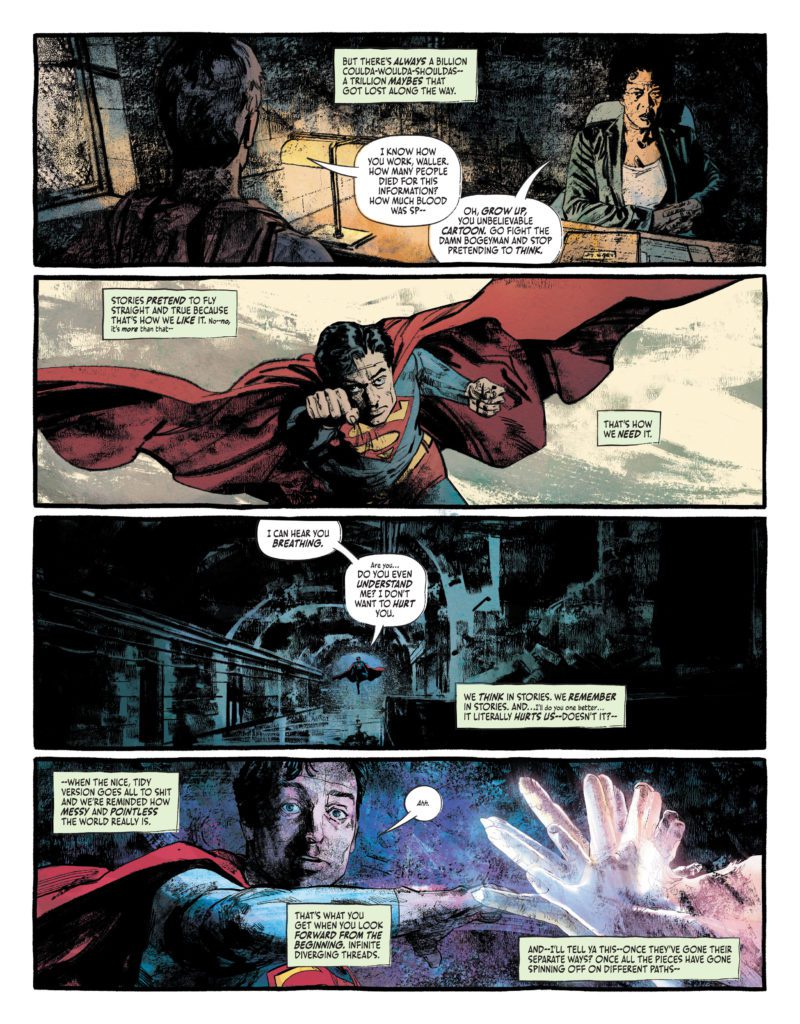I’ve tried to write this review about 100 times already. The fact is, Suicide Squad: Blaze is so unlike anything else, there just aren’t words to do it any justice. At times, it’s an existential search for meaning. Other times, it’s a raunchy romp about kinky sex and metahuman boners. But, at all times, it’s a mesmerizing story that’s as beautiful as it is disgusting. Writer Simon Spurrier, artist Aaron Campbell, colorist Jordie Bellaire, and letterer Aditya Bidikar take us on a wild ride with a bunch of suicidal criminals that have the powers of gods in Suicide Squad: Blaze #2.
About Suicide Squad: Blaze #2:
The inmates who volunteered for the Blaze program are discovering fascinating things about their newfound powers-and about the best ways to torment their Suicide Squad watchdogs. Are they discovering anything about their core mission of stopping the cannibalistic metahuman who’s terrorizing the planet and who, uh…might have just defeated Superman…? Well, slightly less so. But they’re all going to be dead in three months. Or a lot less. Let them have fun, eh?

Writing
This issue begins by telling us what it’s not. The first few pages, narrated by our disillusioned protagonist, takes us through some familiar territory. We see Superman crash landing in Kansas as a baby then being raised by the Kents. Right when you think this story is taking a lighter tone, Spurrier gives us a wake up call. “Oh grow up, you unbelievable cartoon. Go fight the bogeyman and stop pretending to think,” Waller practically spits at the Man of Steel. These aren’t your mom and pop’s comics, Spurrier’s saying. The next scene, a superpowered sex scene between two terribly codependent people, is interrupted by moments of brutal yet somehow beautiful violence. Spurrier writes all of this from the perspective of Van Zandt – our protagonist who’s got the power of invisible arms. (Yes, you read that right.) Van Zandt is cynical about life, yet fascinated by it at the same time. He’s self-aware and self-destructive. With bloody action sequences, quiet quips, and lots of honest soul-searching, Spurrier presents a script that’s crackling with life.
Art
Campbell and Bellaire work so brilliantly in tandem with one another that it’s hard to see where one’s work ends and the other’s begins. Campbell’s linework seems to use bright oranges and greens just as much as it uses blacks. Bellaire’s colors bring shape to moments and characters, while also willfully obscuring details. The normal, run-of-the-mill discussions between our characters are shown with a more traditional approach. Campbell’s lines are clear and Bellaire’s colors stay relatively simple. But when the characters begin using their powers, the page becomes a mass of warring light. Campbell allows us to see small details that surface from the vibrant battles, while zeroing us in on the faces of these suicidal criminals between each bout. Bellaire pulls us right back in with sizzling greens, purples, and reds – which are all working to overcome one another. Campbell and Bellaire do a fantastic job of giving us a combination of realistic and comic book style combat. You come out the other end, unsure about what just happened and still reeling from the glory of the lightshow.

Lettering
Bidikar brings so much character to this script. For one thing, the dialogue and captions are written in one of two formats: either as your typical all-caps lettering, or in a lower case font that’s several font sizes smaller. With this, Bidikar has you hearing characters say things under their breath to each other, or even to themselves. Later, we see Captain Boomerang get more and more drunk as time goes on. His word balloons start out by having a wobbly edge to them. As he gets more intoxicated, the balloons begin to have small white dots around them too. You feel as though Boomerang’s words have begun to come out as a vapor. The white dots remind you of the spittle that’s probably spewing out of his mouth. Throughout this book, Bidikar is constantly changing things up, somehow finding ways to highlight all the most important parts of this chaotic, rollicking adventure.
Verdict
Suicide Squad: Blaze is more than just superhero satire. Sure, it spends plenty of time poking fun at the trappings of your typical comic. But it also rises above all that – and sometimes gleefully sinks below it – to really discuss what it feels like to chase relevancy. This creative team is doing something there aren’t sufficient words for. They’re here to make you laugh, cry, and maybe piss your pants. Don’t miss Suicide Squad: Blaze #2, out from DC Comics today, at a comic shop near you!

